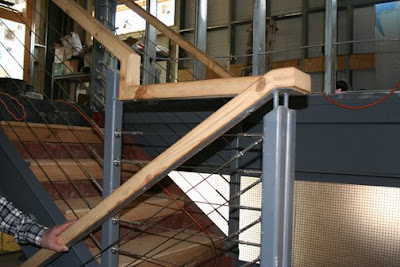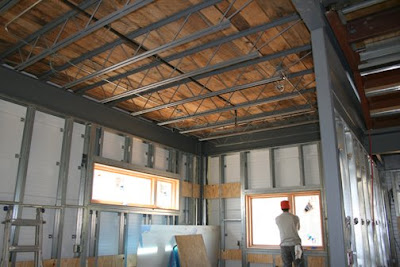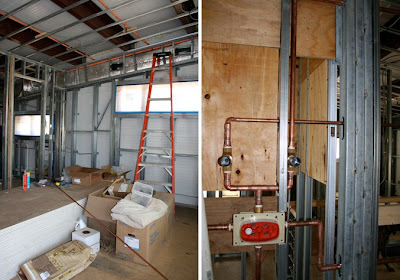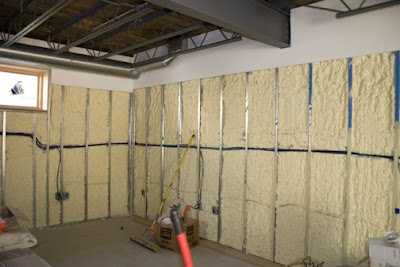Progress on the 30x30 continues by leaps and bounds as the
ductwork, plumbing, and electrical are roughed in. Although this will all be hidden behind drywall, it has been carefully thought out and planned so that the finished product remains clean and simple. Final finishes to the outside have been completed as well. This allows the owner to get a taste of just how energy efficient the structure will be when we go on "walk
throughs". Even with
DC's springtime temperature fluctuations, the interior temperature has remained steady. It's great to see the final product coming together and the fun stuff like faucets, tile and appliances are being chosen next.

The gutters have been added to the outside, along with the final roof trim. The series of stacked windows on the left side of the house will be frosted, as they all look into bathrooms. The frost will also give the windows a continuous, top-to-bottom, flowing look.

Here you can see the continuation of the roof trim, the addition of the handrails on the balcony, and the final color of the steel vertical beams (it's hard to see but they were painted green to match the windows).

Views of the upstairs balcony.
Ipe wood decking was chosen for its hardness and natural resistance to the elements.
Ipe takes very little maintenance. The ends are sealed with a wax to resist cracking and checking. It has a slightly higher up-front cost, but it will last longer than chemically treated woods, and looks better from both above and below than composite decking. Tension cable railing were chosen for its modern
aesthetic and it also allows for the least obstructed view. This large balcony is accessed from the master bedroom and will serve as an excellent escape for the owner. Views of the Potomac River can be seen in the winter from up here.

The interior stairwell is nearly finished. Tension cable railings are carried through from the outside to the inside. Pine wood 2x4s have been
repurposed as the handrails and will probably remain natural.

Old growth "real" oak 2x4s that were salvaged from the old razed house are
repurposed as the stair treads. It is a little hard to see in the picture, but a steel dowel will be placed on the edge of each tread to prevent wear and tear on the aged wood and to add a design accent that fits with the tension cables.


The owner wanted to retain an open feeling between landings but close off direct view into the basement. An acrylic panel with mesh wiring inlaid is used to
accommodate this need. 
Due to the building codes in Montgomery County all new houses must have a sprinkler system. Fortunately, this requirement fits in wonderfully with the open ceiling plan. We chose to keep the sprinkler pipes raw and we cleaned them up with vegetable oil to allow their original color to show through. The rawness of the color works well with the steel beams and electrical conduits will be left raw as well.

All the steel I-beams and joists are painted a neutral but warm grey that goes well with the warmth and aged look of the oak ceiling planks.

A view into the Master bedroom and bath.
Ductwork is lovingly tucked in between the flanges of the steel beams to minimize the final size of the bulkheads. Plumbing is roughed in for the master bath. The wood that you see is blocking for easy attachment of shelving later.

The home is going to be heated and cooled by two zone 16 seer heat pumps. They have variable speed fans so that they can cycle on and off with more efficiency. The home will be so well insulated that it is actually difficult finding HVAC units that are small enough. The picture above is the air handler unit for the upper floor tucked above the ceiling of the hall bath. Access will be through a hinged mirror in the master bath.
 Ductwork
Ductwork in the basement. Two 200 amp electric panels have been roughed in. One panel is for the house. The second one was roughed in to feed a subpanel for a future sea container garage that will be built on the property.

Basement
ductwork will remain exposed. Here's another detail of the acrylic panels placed near the stairwell. A good amount of light can come through them while still preserving privacy.

Although the basement is 5 feet underground and has 12" thick concrete walls, we sprayed 4" of foam insulation to insure the highest level of energy efficiency possible.
 The gutters have been added to the outside, along with the final roof trim. The series of stacked windows on the left side of the house will be frosted, as they all look into bathrooms. The frost will also give the windows a continuous, top-to-bottom, flowing look.
The gutters have been added to the outside, along with the final roof trim. The series of stacked windows on the left side of the house will be frosted, as they all look into bathrooms. The frost will also give the windows a continuous, top-to-bottom, flowing look. Here you can see the continuation of the roof trim, the addition of the handrails on the balcony, and the final color of the steel vertical beams (it's hard to see but they were painted green to match the windows).
Here you can see the continuation of the roof trim, the addition of the handrails on the balcony, and the final color of the steel vertical beams (it's hard to see but they were painted green to match the windows). Views of the upstairs balcony. Ipe wood decking was chosen for its hardness and natural resistance to the elements. Ipe takes very little maintenance. The ends are sealed with a wax to resist cracking and checking. It has a slightly higher up-front cost, but it will last longer than chemically treated woods, and looks better from both above and below than composite decking. Tension cable railing were chosen for its modern aesthetic and it also allows for the least obstructed view. This large balcony is accessed from the master bedroom and will serve as an excellent escape for the owner. Views of the Potomac River can be seen in the winter from up here.
Views of the upstairs balcony. Ipe wood decking was chosen for its hardness and natural resistance to the elements. Ipe takes very little maintenance. The ends are sealed with a wax to resist cracking and checking. It has a slightly higher up-front cost, but it will last longer than chemically treated woods, and looks better from both above and below than composite decking. Tension cable railing were chosen for its modern aesthetic and it also allows for the least obstructed view. This large balcony is accessed from the master bedroom and will serve as an excellent escape for the owner. Views of the Potomac River can be seen in the winter from up here.  The interior stairwell is nearly finished. Tension cable railings are carried through from the outside to the inside. Pine wood 2x4s have been repurposed as the handrails and will probably remain natural.
The interior stairwell is nearly finished. Tension cable railings are carried through from the outside to the inside. Pine wood 2x4s have been repurposed as the handrails and will probably remain natural. Old growth "real" oak 2x4s that were salvaged from the old razed house are repurposed as the stair treads. It is a little hard to see in the picture, but a steel dowel will be placed on the edge of each tread to prevent wear and tear on the aged wood and to add a design accent that fits with the tension cables.
Old growth "real" oak 2x4s that were salvaged from the old razed house are repurposed as the stair treads. It is a little hard to see in the picture, but a steel dowel will be placed on the edge of each tread to prevent wear and tear on the aged wood and to add a design accent that fits with the tension cables. 
 The owner wanted to retain an open feeling between landings but close off direct view into the basement. An acrylic panel with mesh wiring inlaid is used to accommodate this need.
The owner wanted to retain an open feeling between landings but close off direct view into the basement. An acrylic panel with mesh wiring inlaid is used to accommodate this need.  Due to the building codes in Montgomery County all new houses must have a sprinkler system. Fortunately, this requirement fits in wonderfully with the open ceiling plan. We chose to keep the sprinkler pipes raw and we cleaned them up with vegetable oil to allow their original color to show through. The rawness of the color works well with the steel beams and electrical conduits will be left raw as well.
Due to the building codes in Montgomery County all new houses must have a sprinkler system. Fortunately, this requirement fits in wonderfully with the open ceiling plan. We chose to keep the sprinkler pipes raw and we cleaned them up with vegetable oil to allow their original color to show through. The rawness of the color works well with the steel beams and electrical conduits will be left raw as well.  All the steel I-beams and joists are painted a neutral but warm grey that goes well with the warmth and aged look of the oak ceiling planks.
All the steel I-beams and joists are painted a neutral but warm grey that goes well with the warmth and aged look of the oak ceiling planks.  A view into the Master bedroom and bath. Ductwork is lovingly tucked in between the flanges of the steel beams to minimize the final size of the bulkheads. Plumbing is roughed in for the master bath. The wood that you see is blocking for easy attachment of shelving later.
A view into the Master bedroom and bath. Ductwork is lovingly tucked in between the flanges of the steel beams to minimize the final size of the bulkheads. Plumbing is roughed in for the master bath. The wood that you see is blocking for easy attachment of shelving later. The home is going to be heated and cooled by two zone 16 seer heat pumps. They have variable speed fans so that they can cycle on and off with more efficiency. The home will be so well insulated that it is actually difficult finding HVAC units that are small enough. The picture above is the air handler unit for the upper floor tucked above the ceiling of the hall bath. Access will be through a hinged mirror in the master bath.
The home is going to be heated and cooled by two zone 16 seer heat pumps. They have variable speed fans so that they can cycle on and off with more efficiency. The home will be so well insulated that it is actually difficult finding HVAC units that are small enough. The picture above is the air handler unit for the upper floor tucked above the ceiling of the hall bath. Access will be through a hinged mirror in the master bath. Ductwork in the basement. Two 200 amp electric panels have been roughed in. One panel is for the house. The second one was roughed in to feed a subpanel for a future sea container garage that will be built on the property.
Ductwork in the basement. Two 200 amp electric panels have been roughed in. One panel is for the house. The second one was roughed in to feed a subpanel for a future sea container garage that will be built on the property.  Basement ductwork will remain exposed. Here's another detail of the acrylic panels placed near the stairwell. A good amount of light can come through them while still preserving privacy.
Basement ductwork will remain exposed. Here's another detail of the acrylic panels placed near the stairwell. A good amount of light can come through them while still preserving privacy. Although the basement is 5 feet underground and has 12" thick concrete walls, we sprayed 4" of foam insulation to insure the highest level of energy efficiency possible.
Although the basement is 5 feet underground and has 12" thick concrete walls, we sprayed 4" of foam insulation to insure the highest level of energy efficiency possible. 